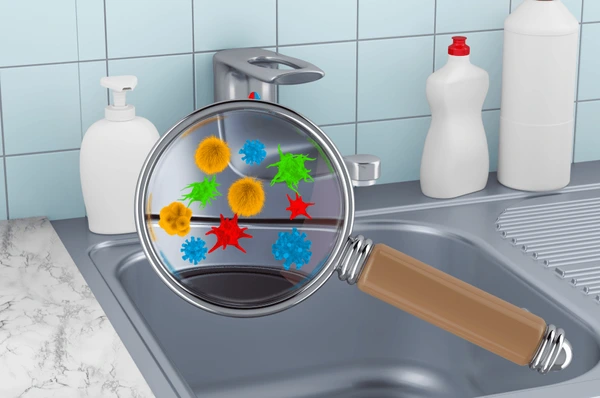
That trusty toilet seat everyone assumes is the germiest spot in your home? It's practically sterile compared to some everyday items you're touching right now.
While most of us give the loo a good scrub multiple times a week, senior Australians are particularly vulnerable to getting sick, and for them, flu and gastro can also be life threatening.
This makes understanding household germ hotspots more crucial than ever for maintaining good health as we age.
'Senior Australians are particularly vulnerable to getting sick. For them, flu and gastro can also be life threatening'
The reality is, a toilet seat has only 50 bacteria per square inch, whereas a kitchen sponge has 10 million bacteria per square inch.
But recent research reveals even more staggering numbers—kitchen sponges contain as many as 54 billion bacteria per cubic centimetre.
That's more than the population of the entire world living in a space smaller than your fingernail.
Jessica Ek from the American Cleaning Institute puts it perfectly: 'Most people think a toilet seat is one of the germiest places there is, but it's one of the places nearly all of us regularly clean. What tends to get dirtier are the places we touch a lot but take for granted.'
The surprising science behind household germs
As elderly people are more likely to have pre-existing conditions such as heart, lung or kidney disease, their body's ability to fight infectious diseases is decreased. This means that everyday household bacteria pose a greater risk than you might realise.
Why seniors face higher infection risks
Your immune system fights germs and viruses that cause disease. But many conditions and treatments weaken your immune system. If your immune system is compromised, you are more likely to become severely ill from common household bacteria.
The dirty dozen (plus two): Australia's germiest household items
Kitchen culprits that put toilets to shame
1. Kitchen sponges: The bacterial metropolis
A kitchen sponge is 200,000 times dirtier than a toilet seat. Research shows the dominating bacterial classes include Gammaproteobacteria, with common genera like Acinetobacter, Enhydrobacter, Pseudomonas, and Chryseobacterium present regardless of variations in utensil type, storage conditions, or cleaning procedures.
The good news? Sponges that were reported to dry in-between usage events showed significantly lower bacterial counts, and microwaving the wet sponge on high for 1 minute, soaking in 10 per cent bleach for 1 minute, or running through the dishwasher on the hot cycle are effective cleaning methods.
2. Kitchen sink: The bacterial breeding ground
Your kitchen sink ranks as the second-highest area for bacterial contamination. Studies found that 75 per cent of household sponges and dishcloths had Coliform bacteria (including E. coli), with coliform bacteria usually indicating fecal contamination.
3. Cutting boards: 200 times dirtier than toilet seats
Kitchen sponges represent an important vehicle of microbial transmission and maintenance of spoilage bacteria and pathogenic strains, as they are frequently used not only to clean dishes but also different surfaces or refrigerator shelves, increasing the risk of cross-contamination.
Technology and frequently-touched items
4. Mobile phones: Pocket-sized germ factories
Researchers found that cellphones carry ten times more bacteria than a toilet seat, with some studies finding serious pathogens like E-Coli, MRSA, and Strep. The cross-contamination happens most often in the kitchen while cooking.
5. Remote controls and keyboards
Kitchens are among the most contaminated domestic environments, even more than some bathroom areas like toilet seats, door knobs, or commonly used objects such as cellular phones and keyboards.
6. Your desk
If you work from home, your desk harbours approximately 400 times more germs than a toilet seat—and that's before considering what's accumulated on your keyboard and mouse.
Essential cleaning priorities for Australian seniors
- Clean kitchen sponges daily or replace weekly
- Disinfect mobile phones with alcohol wipes daily
- Wash cutting boards after each use, especially after raw meat
- Dry sponges completely between uses
- Wipe down remote controls and keyboards weekly
Personal care items with hidden dangers
7. Toothbrushes and holders
Stored in humid bathroom conditions, toothbrushes naturally attract bacteria. The simple act of closing the toilet lid before flushing prevents fecal particles from contaminating your oral hygiene tools.
8. Bedding: The weekly bacterial explosion
After just one week, pillowcases contain 17,000 more bacteria particles than a toilet seat. Between sweat, oils, dead skin, and beauty products, our bedding becomes a bacterial haven faster than we realise.
9. Water bottles: 400,000 times the bacteria
Reusable water bottles average 400,000 times more bacteria than toilet seats, with spout and screw-top styles being the worst offenders. Regular hand washing is a healthy habit for seniors to maintain, ensuring they wash for 30 seconds or more with soap and water as soon as they get home from an outing.
Surprising household germ harbourers
10. Pet bowls: Hidden health hazards
Dog food bowls frequently contain dangerous bacteria including Clostridium difficile (C diff). Washing pet bowls after each meal and keeping them dry prevents bacterial growth.
11. Doorknobs, light switches and cabinet hardware
Internal bathroom door handles are the dirtiest, with an average of 93 bacteria colonies per square centimetre of surface—almost eight times dirtier than a toilet seat.
12. Refrigerator handles
Cross-contamination during meal preparation makes fridge handles particular hotspots. A daily wipe-down with disinfectant, especially after handling raw meat, keeps bacterial transfer at bay.
13. Reusable shopping bags
While environmentally friendly, unwashed reusable bags become bacterial breeding grounds. Machine-wash fabric bags regularly, and reserve specific bags for raw meat to prevent cross-contamination.
14. Tea towels and dishcloths
Dishcloths and sponges harbor the largest amount of E. coli and other fecal bacteria, with each square inch containing 456 times more bacteria than a toilet seat.
Simple solutions for a cleaner, safer home
The key to managing household germs isn't panicking—it's developing simple, consistent habits that work for your lifestyle.
For kitchen items, focus on drying sponges between uses and replacing them weekly. Thorough and consistent hand-washing, personal hygiene checklists, and regular cleaning and disinfecting of household items can assist in preventing identified hygiene risks.
Consider switching from sponges to brushes where possible—they're easier to clean and dry more thoroughly. For frequently-touched items like phones and remote controls, keep alcohol wipes handy for daily cleaning.
Did you know?
Did you know?
According to research, a kitchen sponge is actually a better incubator for diverse bacterial communities than a laboratory petri dish, providing the perfect environment for bacteria to thrive and multiply.
Creating your personal hygiene routine
Creating personal hygiene checklists can be useful reminders to ensure hygiene practices are as healthy as possible, whether in the bathroom, kitchen, or bedroom.
Start with the highest-risk items: kitchen sponges, mobile phones, and cutting boards. Build these cleaning habits gradually—trying to overhaul everything at once often leads to giving up entirely.
Remember, the goal isn't a sterile environment. There are more bacterial cells in our body than human cells, and most of the time bacteria do not bother us—we happily share our world with them. It's about reducing the risky bacteria that can cause illness, particularly important for those with compromised immune systems.
What This Means For You
The bottom line? While your toilet seat deserves its regular cleaning, don't forget about these hidden germ harbourers that need just as much attention. A few simple changes to your cleaning routine can significantly reduce your exposure to harmful bacteria and help keep you healthier.
What's the germiest item in your home that surprised you most? Have you discovered any clever cleaning tricks that work well for you? Share your thoughts and experiences in the comments below—your fellow readers would love to hear your practical solutions for keeping these household hotspots under control.
Original Article
https://www.bhg.com/household-items-dirtier-than-toilet-11812905
Managing infectious diseases in aged care | Australian Government Department of Health, Disability and Ageing
Cited text: Senior Australians are particularly vulnerable to getting sick. For them, flu and gastro can also be life threatening.
Excerpt: senior Australians are particularly vulnerable to getting sick, and for them, flu and gastro can also be life threatening
https://www.health.gov.au/topics/ag...ing-and-guidance/managing-infectious-diseases
Can bacteria live on toilet seats?
Cited text: For example, a toilet seat has only 50 bacteria per square inch, whereas a kitchen sponge has 10 million bacteria per square inch.
Excerpt: a toilet seat has only 50 bacteria per square inch, whereas a kitchen sponge has 10 million bacteria per square inch
https://www.calendar-australia.com/faq/can-bacteria-live-on-toilet-seats
Kitchen sponges are bacteria’s dream home
Cited text: Those sponges contain as many as 54 billion bacteria per cubic centimeter (one sixteenth of a cubic inch)!
Excerpt: kitchen sponges contain as many as 54 billion bacteria per cubic centimetre
https://www.snexplores.org/article/sponge-kitchen-bacteria-microbe-diversity
How To Identify And Prevent Hygiene Risks For The Elderly
Cited text: As elderly people are more likely to have pre-existing conditions such as heart, lung or kidney disease, their body’s ability to fight infectious dise...
Excerpt: As elderly people are more likely to have pre-existing conditions such as heart, lung or kidney disease, their body's ability to fight infectious diseases is decreased
https://www.propertyclearance.com.a...ow-to-identify-prevent-risks-for-elderly/amp/
High-risk groups and settings for COVID-19 | Australian Government Department of Health, Disability and Ageing
Cited text: Your immune system fights germs and viruses that cause disease. But many conditions and treatments weaken your immune system. If your immune system is...
Excerpt: Your immune system fights germs and viruses that cause disease. But many conditions and treatments weaken your immune system.
https://www.health.gov.au/topics/covid-19/high-risk-groups-and-settings
Can bacteria live on toilet seats?
Cited text: In other words, a kitchen sponge is 200,000 times dirtier than a toilet seat, and a dishcloth is 20,000 times dirtier.
Excerpt: A kitchen sponge is 200,000 times dirtier than a toilet seat
https://www.calendar-australia.com/faq/can-bacteria-live-on-toilet-seats
Bacterial levels and diversity in kitchen sponges and dishwashing brushes used by consumers—PMC
Cited text: In both the present (Figures 1 and 2, Table 3) and the German studies, the dominating bacterial class were Gammaproteobacteria, and many of the same g...
Excerpt: the dominating bacterial classes include Gammaproteobacteria, with common genera like Acinetobacter, Enhydrobacter, Pseudomonas, and Chryseobacterium present regardless of variations in utensil type, storage conditions, or cleaning…
https://pmc.ncbi.nlm.nih.gov/articles/PMC9542536/
Bacterial levels and diversity in kitchen sponges and dishwashing brushes used by consumers—PMC
Cited text: Based on the present and the two German studies, this suggests that there may be a set of common bacteria, with Acinetobacter, Enhydrobacter, Pseudomo...
Excerpt: the dominating bacterial classes include Gammaproteobacteria, with common genera like Acinetobacter, Enhydrobacter, Pseudomonas, and Chryseobacterium present regardless of variations in utensil type, storage conditions, or cleaning…
https://pmc.ncbi.nlm.nih.gov/articles/PMC9542536/
Bacterial levels and diversity in kitchen sponges and dishwashing brushes used by consumers—PMC
Cited text: Further, two reported practices gave a significant lower TVC; sponges cleaned in the dishwasher (p = 0.039, mean = 8.8 log [4 items]) and sponges repo...
Excerpt: Sponges that were reported to dry in-between usage events showed significantly lower bacterial counts
https://pmc.ncbi.nlm.nih.gov/articles/PMC9542536/
Kitchen Hygiene: Let’s Talk About That Sponge! | Home & Garden Information Center
Cited text: Here are some good ways to clean a sponge: Microwave the wet sponge on high for 1 minute (but only if the sponge doesn’t have any metal in it); soak t...
Excerpt: microwaving the wet sponge on high for 1 minute, soaking in 10 per cent bleach for 1 minute, or running through the dishwasher on the hot cycle are effective cleaning methods
https://hgic.clemson.edu/factsheet/kitchen-hygiene-lets-talk-about-that-sponge/
Kitchen Hygiene: Let’s Talk About That Sponge! | Home & Garden Information Center
Cited text: They found that 75 per cent of the household sponges and dishcloths had Coliform bacteria (think E. coli, which is a type of coliform bacteria). Coliform bact...
Excerpt: Studies found that 75 per cent of household sponges and dishcloths had Coliform bacteria (including E. coli), with coliform bacteria usually indicating fecal contamination
https://hgic.clemson.edu/factsheet/kitchen-hygiene-lets-talk-about-that-sponge/
Study on microbial communities in domestic kitchen sponges: Evidence of Cronobacter sakazakii and Extended Spectrum Beta Lactamase (ESBL) producing bacteria—PMC
Cited text: Kitchen sponges represent an important vehicle of microbial transmission and maintenance of spoilage bacteria and pathogenic strains responsible for f...
Excerpt: Kitchen sponges represent an important vehicle of microbial transmission and maintenance of spoilage bacteria and pathogenic strains, as they are frequently used not only to clean dishes but also different surfaces or refrigerator shelves,…
https://pmc.ncbi.nlm.nih.gov/articles/PMC6379783/
Study on microbial communities in domestic kitchen sponges: Evidence of Cronobacter sakazakii and Extended Spectrum Beta Lactamase (ESBL) producing bacteria—PMC
Cited text: They are, indeed, frequently used not only to clean dishes and cookware, but also, different surfaces or even refrigerators shelves, increasing the ri...
Excerpt: Kitchen sponges represent an important vehicle of microbial transmission and maintenance of spoilage bacteria and pathogenic strains, as they are frequently used not only to clean dishes but also different surfaces or refrigerator shelves,…
https://pmc.ncbi.nlm.nih.gov/articles/PMC6379783/
Can bacteria live on toilet seats?
Cited text: Takedown request | View complete answer on healthymepa.com · Researchers at the University of Arizona found that cellphones carry ten times more bacte...
Excerpt: Researchers found that cellphones carry ten times more bacteria than a toilet seat, with some studies finding serious pathogens like E-Coli, MRSA, and Strep
https://www.calendar-australia.com/faq/can-bacteria-live-on-toilet-seats
Study on microbial communities in domestic kitchen sponges: Evidence of Cronobacter sakazakii and Extended Spectrum Beta Lactamase (ESBL) producing bacteria—PMC
Cited text: Kitchens are included among the most contaminated domestic environments, even more of some bath’s areas (toilette seat, door knob, light switch, toile...
Excerpt: Kitchens are among the most contaminated domestic environments, even more than some bathroom areas like toilet seats, door knobs, or commonly used objects such as cellular phones and keyboards
https://pmc.ncbi.nlm.nih.gov/articles/PMC6379783/
How To Identify And Prevent Hygiene Risks For The Elderly
Cited text: Regular hand washing is a healthy habit for seniors to maintain, ensuring that they wash for 30 seconds or more with soap and water, as soon as they g...
Excerpt: Regular hand washing is a healthy habit for seniors to maintain, ensuring they wash for 30 seconds or more with soap and water as soon as they get home from an outing
https://www.propertyclearance.com.a...ow-to-identify-prevent-risks-for-elderly/amp/
Can bacteria live on toilet seats?
Cited text: Takedown request | View complete answer on wmar2news.com · According to the research, internal bathroom door handles are the dirtiest, with an average...
Excerpt: Internal bathroom door handles are the dirtiest, with an average of 93 bacteria colonies per square centimetre of surface—almost eight times dirtier than a toilet seat
https://www.calendar-australia.com/faq/can-bacteria-live-on-toilet-seats
Can bacteria live on toilet seats?
Cited text: Dishcloths and sponges are dirtier than any other item in the average home, harboring the largest amount of E. coli and other fecal bacteria—mostly be...
Excerpt: Dishcloths and sponges harbor the largest amount of E. coli and other fecal bacteria, with each square inch containing 456 times more bacteria than a toilet seat
https://www.calendar-australia.com/faq/can-bacteria-live-on-toilet-seats
How To Identify And Prevent Hygiene Risks For The Elderly
Cited text: Thorough and consistent hand-washing, personal hygiene checklists, and regular cleaning and disinfecting of household items can assist in preventing i...
Excerpt: Thorough and consistent hand-washing, personal hygiene checklists, and regular cleaning and disinfecting of household items can assist in preventing identified hygiene risks
https://www.propertyclearance.com.a...ow-to-identify-prevent-risks-for-elderly/amp/
Your Kitchen Sponge Is a Better Home for Bacteria Than a Petri Dish
Cited text: According to the new research, a sponge is a better incubator for diverse bacterial communities than a laboratory petri dish.
Excerpt: According to research, a kitchen sponge is actually a better incubator for diverse bacterial communities than a laboratory petri dish
https://www.smithsonianmag.com/smar...nge-is-the-ideal-home-for-bacteria-180979668/
How To Identify And Prevent Hygiene Risks For The Elderly
Cited text: Another useful way to implement best hygiene practices for seniors is to create personal hygiene checklists. Whether in the bathroom, kitchen, or bedr...
Excerpt: Creating personal hygiene checklists can be useful reminders to ensure hygiene practices are as healthy as possible, whether in the bathroom, kitchen, or bedroom
https://www.propertyclearance.com.a...ow-to-identify-prevent-risks-for-elderly/amp/
Kitchen Sponge Panic | Office for Science and Society—McGill University
Cited text: In fact, there are more bacterial cells in our body than human cells! Of course, most of the time bacteria do not bother us, we happily share our worl...
Excerpt: There are more bacterial cells in our body than human cells, and most of the time bacteria do not bother us—we happily share our world with them
https://www.mcgill.ca/oss/article/general-science/kitchen-sponge-panic-0







